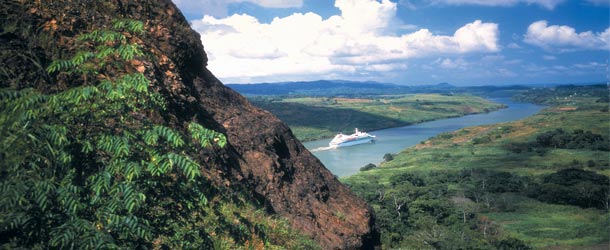One of the greatest feats of engineering that has ever been accomplished plays an integral part in many cruise itineraries. The Panama Canal is an incredible achievement that has opened up a world of possibilities for trade and military, and as time has progressed for travel too. It allows people who are sailing around the region to visit both the Pacific and the Atlantic Oceans without the need to travel the huge distance around Cape Horn, a huge benefit to every industry.
It all started back in 1855 with a report by William Kennish, working for the US Government at the time, regarding the importance of a canal to connect the two major oceans. However the US weren’t the first to attempt the building of a canal. That was the French, following the success of the Suez Canal in Egypt connecting Europe and northern Africa with the Middle East and the south-east of Africa.
However without the proper research into the geology of the region the effort was doomed to fail, with bankruptcy calling a halt following a spend of $287 million and, more significantly, a loss of an estimated 22,000 lives due to the tropical conditions, a combination of accident and disease including malaria and yellow fever. The failed attempt, from 1881-89, still laid a lot of the groundwork for the eventual success of the canal when it was picked up by the United States in 1904.
Construction began and took a decade, completed in the same month that the First World War broke out in Europe. With improvements in the working conditions and more of an understanding of the threat carried by mosquitos, the death toll for the American construction of the canal was significantly lower than the French attempt although still numbered over 5,000 workers.
The canal is an interesting shape in that generally it travels from the Atlantic, the eastern sea, to the Pacific in a northwest to southeast direction, thanks to the shape of the isthmus that connects North and South America. Through a combination of artificial lakes and locks, ships can manage the 8 inch height difference between both oceans.
The canal originally belonged to the US, but in 1977 the Torrijos-Carter Treaty was signed, coming into force in 1979. This began a handover period that lasted 20 years and gradually increased the responsibility of Panama until, on 31st December 1999, Panama took full ownership.
There are still plans to continue development of the canal in order to allow more traffic, including larger ships that currently cannot pass. Among the cruise lines that currently traverse the canal are Regent Seven Seas, and Silversea, both of which offer a variety of sailings between the Caribbean and South America.
A new set of locks are in construction with further maintenance for the existing locks ensuring ships that surpass the existing Panamax size can use the canal, with work scheduled to be completed in 2015.
One of the major reasons these works are needed is due to the current success that has seen nearly 300 million tons of shipping pass through the canal every year. Considering the original plans were for the canal to have a maximum capacity of 80 million tons a year, this shows how useful the canal has become and the importance of making improvements.
It’s no wonder that it’s judged to be one of the seven wonders of the modern world, and no wonder that Panama Canal cruises are always popular with travellers.
By Ian Lewis
Google




Comments: no replies